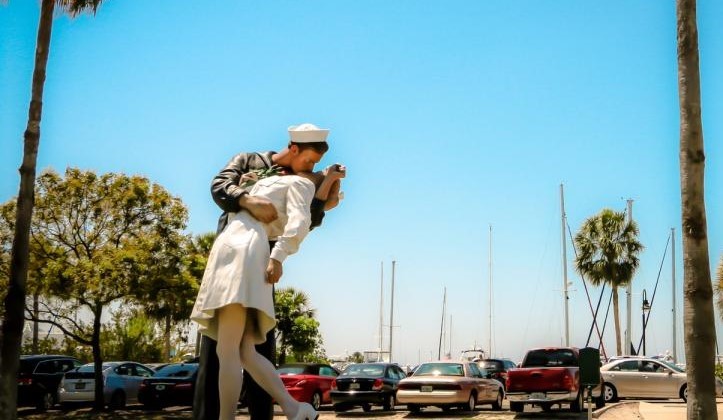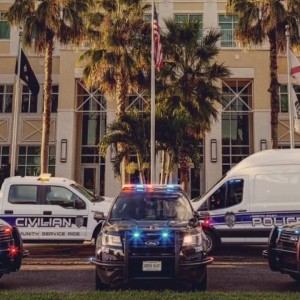Unconditional Surrender’s Mixed Signals
Letters
SRQ DAILY
SATURDAY JUL 25, 2020 |
BY KELLY FRANKLIN
As described by Alfred Eisenstaedt in the captions of his famous photograph as well as in subsequent memoirs, what he witnessed on August 15, 1945 in Times Square, was an inebriated sailor lunging forward and grabbing a woman from the crowd.
In Eisenstaedt’s four frames (and in the public domain shot of the same pair from the waist up by Navy photographer Victor Jorgensen), the faces of the primary subjects are obscured, and many individuals came forward over the years claiming to be either the nurse or sailor. In 2012, a book entitled The Kissing Sailor, by a naval college professor and a historian, settled the long-running mystery by using contemporaneous accounts from the participants and onlookers and forensic analysis of the images.
The sailor in Eisdenstadt’s image was George Mendonsa, of Rhode Island. The “nurse” was Greta Zimmer (later Friedman), an Austrian-born émigré whose parents died in Nazi concentration camps. Working as a dental hygienist at the time, Greta ventured to Times Square on her lunch hour to see if the rumors she had heard about the war ending were true. Mendonsa, who had seen combat in the Pacific, spotted a woman on the street wearing a white uniform who reminded him of the nurses tending wounded sailors on a battleship. He bowled into her, knocked her off her feet, put her in a headlock, bent her over backward into a physically painful and subordinate position, and forcibly kissed her for 4 to 5 seconds while she struggled and clutched her purse and balled up her fist to push him away.
Although individuals who lived through that day bristle when the modern phrase “sexual assault” is applied retroactively to the events that occurred, the case that the incident in Times Square was unilateral, forceful and lacked consent, is best made by the unwilling participant:
“It wasn’t my choice to be kissed,” Greta stated in a 2005 interview. “The guy just came over and grabbed!” she said. “That man was very strong. I wasn’t kissing him. He was kissing me. I did not see him approaching, and before I know it I was in this tight grip.”
Greta said she was proud to be part of an iconic moment in history, but also spoke poignantly of her fear in that moment and shame that kept her from coming forward for 30 years lest her fiancé think her a willing participant in the “celebration.” Indeed, the Eisenstaedt photo’s Time/Life noted in 2000 “many people view the photo as little more than the documentation of a very public sexual assault, and not something to be celebrated.” Even military leaders acknowledge this fact. For example, in a 2013 issue of Foreign Policy’s Situation Report, a senior active-duty military official noted is "a sailor, soldier or Marine were to do the same thing, aggressively kissing strange women in the street with no prior consent, he would be facing charges under Article 120."
My primary concern is not what the proper label is for George Mendonsa’s aggressive actions in the context of a singular day in history in another city 75 years ago, but rather about the interactive dystopian diorama created by the super-sized, romanticized, 3-D depiction of this long misunderstood moment on Sarasota’s bayfront.
I empathize with the profound attachment that those who lived through that horrible war have for the long-mysterious photo, which came to symbolically represent for them love and joy and valor and sacrifice and reunion and relief. But to eyes that did not live through WWII, particularly for those who have experienced sexual violence, it is repellent and dangerous to see loving couples contorting themselves to emulate what was a forced and unwelcome kiss Greta herself refused numerous entreaties to recreate because, as she told the Veteran’s History Project in 2005, “it wasn't a romantic event”.
The sculptor’s creator, Seward Johnson, was explicitly interested in challenging our ideas and ideals with his “Icon” series (which includes not only Unconditional Surrender, but also an oversized portrait of Marilyn Monroe with her dress up and a 25-foot-tall nude Barbie on a half shell). As part of his effort to tap into Jungian archetypes and “skirt” copyright, he substituted romantic flowers for the purse Greta guarded during the struggle, and added extra flare to her white uniform to provide a peek-a-boo moment and morph her from victim into temptress.
The sculpture’s mixed signals encourage emulatory behavior, which disrespects to the memory of the modest woman depicted in the iconic photo. These confusing signs can also have painfully acute associations for those who intuitively recognize (from the off-balance stance of the female figure, the deep and painful arch to her back, and elbow encircling her head) the vanquishing elements of the moment, and suffer flashbacks to their own experiences of being intimately overpowered. Holocaust survivor Greta Zimmer Friedman deserves better than what this sculpture depicts. The women, children, and men who have experienced sexual violence deserve better. Sarasota’s many veterans who have given so much in so many wars, and those, like me, who are deeply grateful for their service, deserve better. There must be a better way for the artistically rich city of Sarasota to commemorate joy, recognize struggle and celebrate life through public art than is afforded by Unconditional Surrender.
Kelly Johnson is a resident of Sarasota.
« View The Saturday Jul 25, 2020 SRQ Daily Edition
« Back To SRQ Daily Archive











